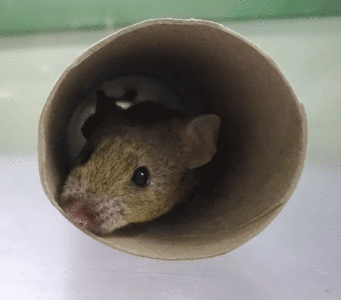
Mice: Husbandry and breeding
Most of the mice held at the Max Planck Institutes come from the Institutes’ own breeding programmes, though some are also obtained from professional breeders of lab animals. Trained animal keepers together with veterinarians ensure the animals’ welfare, which takes their natural basic needs into account as far as possible.

Like house mice, the laboratory animals are flight animals. In nature they spend most of their time in underground burrows. They are good diggers and climbers and are primarily nocturnal. When they leave their burrows, they keep close to walls and avoid open areas. In captivity too, the rodents need room for movement and ways to hide and build nests.
Mice have a lively social life. They communicate mainly through sounds and smells. Depending on the food supply, wild mice live in differently sized family groups consisting of a dominant male, several females and young animals. Male animals form territories, which they defend against other males. Mature males challenge territory owners to combat, sometimes to the death, or migrate away to establish their own territory. Sometimes, however, they are tolerated by the dominant male.
Most of the mice held by the Max Planck Society also live in groups. The young are separated from their mothers after weaning and are kept in groups of the same sex. Only mature males that have mated with a female often have to be isolated, as they then become so dominant that they can no longer be kept in a group.

The mice are kept in see-through plastic cages with an area of at least 370 square centimetres. Three to six mice live in each cage, depending on their weight. The cages are 14 centimetres high and are covered by a grating, which the animals use for climbing. The cages contain a feed trough and water bottle.
Each cage contains litter of wood shavings or chips. Small hiding places made of red, transparent plastic – known as mouse houses − serve as retreats. Paper strips, excelsior or hemp provide material for nest building and activity. A standardized complete feed in pellet form that provides all the required nutrients and water are freely available. A fully automated climate and light control system ensures that the mice are kept under constant temperature, humidity and light conditions.
Hygiene
The primary concern in animal holding is the health of the mice, not least because scientists can only obtain meaningful results from animals with a uniform health status. Protection against infections is particularly important, because when thousands of animals are living cheek by jowl, diseases can spread quickly.

Animal keepers therefore aim to ensure the highest standards of hygiene possible. The mice are usually transferred to new cages with fresh litter every week. Depending on the type of cage, specifications exist for the regular cleaning and disinfecting of all materials and the wearing of suitable safety clothing. These procedures protect the animals from pathogens and humans from allergens.
Ultra-fine microfiltres purify the ambient air. Genetically modified mice with an impaired immune system are less able to fend off pathogens in the environment and are therefore kept in special cages or isolation units.


